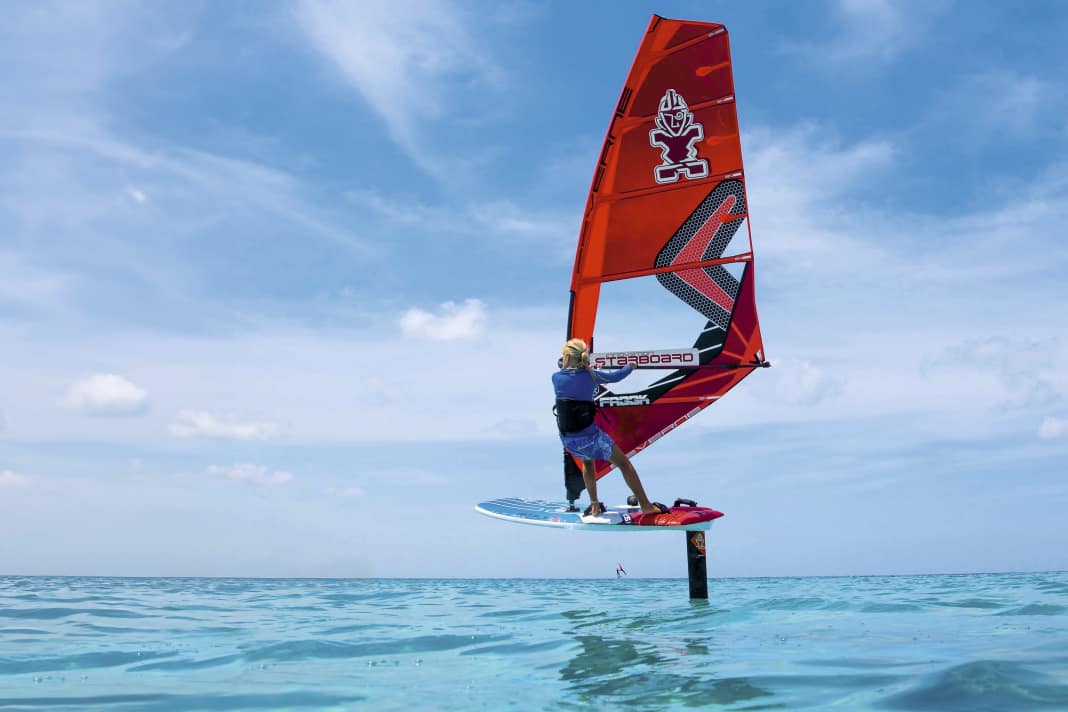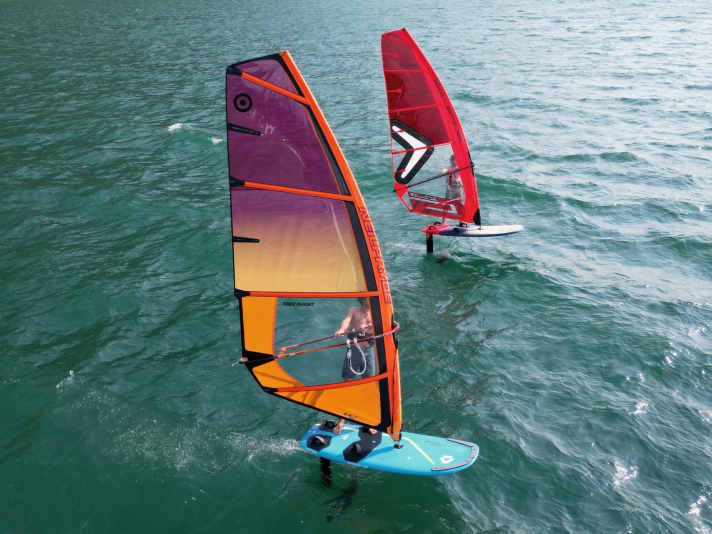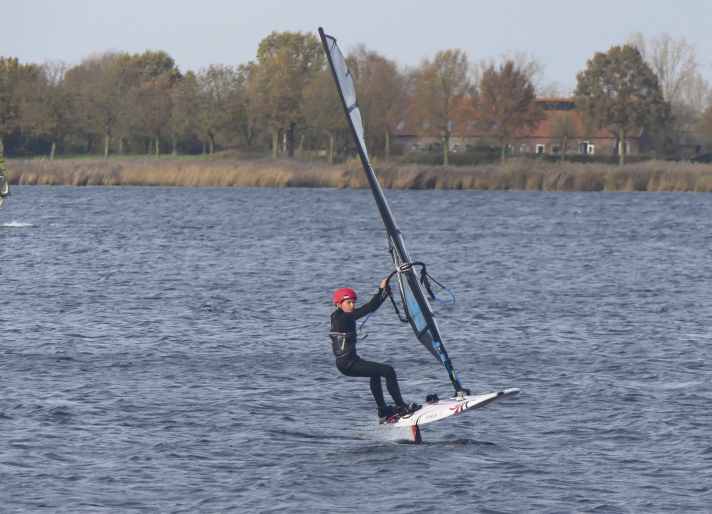





- Modern material makes foiling child's play
- The right board and foil to get you started
- Help required - the trim must be right
- Learning trick: voluntary flight ban despite foil
- The best sails for foiling
- Get children out into the (fresh) air!
- Checklist for your first windsurfing attempts on the foil
Whether you like it or not - in light winds, from around seven to eight knots, foils are more efficient than any other hull shape. When tacking, sailing and even windsurfing. Many windsurfers swap their large light wind sail for a small foil board with a wing in the sky - often because the material is easier to transport and easier to set up than a windsurf sail. Wingfoiling, on the other hand, is much easier to learn and gets you in the air sooner, but only on Instagram and in marketing. The planing duel between wing and sail ends in a draw and most foil newbies get "ready for take-off" on a windsurfing foil even faster than with a wing.
"We have 150 students a week in summer, and windsurf foiling is a niche product that we only teach in private lessons," says Heinz Stickl from Stickl Sportcamp, "but if you can glide well in a harness without a daggerboard and have a board with enough volume, then it's not rocket science. You really don't need a week's course to get onto a windsurfing foil. When it comes to wingfoiling, people are told how easy it is to learn through Instagram videos and statements in the shop. But it's not quite that simple. You don't start wingfoiling on a small foil board straight away, but first without a foil on a large SUP board. Not everyone succeeds in switching from kneeling to standing the first time. As a rule, the most talented participants ride a 120-litre foil board for the first time on the third day of the course and are then able to fly 50 metres."
You don't even need to be able to glide on a Go-Fly to learn to foil. But I would recommend buying a slightly smaller board." (Stefan Edtmayer, Starboard)
Modern material makes foiling child's play
Henning Terstiege, windsurfing coach and Patrik's marketing manager, doesn't set the batten too high for a successful entry into foil windsurfing either: "I know people who could just about surf in the loops - far from the power jibe level - but who still learnt to foil." However, according to Henning, a stable material set-up is particularly important when riding skills are low: "You can't cheat your way through with a bad trim or set-up like on the fin. Only very experienced windsurfers can do that." Stefan Edtmayer from Starboard is of the same opinion: "In the early days of foiling, certain foils were sold very cheaply in large numbers, which simply didn't start early and didn't work well." And he even claims: "On the current Go-Fly, you don't have to be able to glide at all and can also foil without a harness and without foot straps."

What sounds daring actually seems possible after our tests of intermediate foil boards such as the Starboard Go-Fly or Duotone Stingray. In comparison to the delicate foils on narrower boards, on which you skid across the water like a unicycle, the new models are as stable in the air as a go-kart on the road.
The right board and foil to get you started
A suitable (beginner) foil board should be at least 75 to 80 centimetres wide, which can also be a freeride or freerace board with a foil box. The length should not exceed around 2.35 metres, otherwise the bow will push down too much. Foilboards are therefore significantly shorter. Experts agree on the length of the mast: around 85 to 95 centimetres is a good length to give you enough time to react in choppy water. A long fuselage of 90 to 105 centimetres ensures the desired high stability around the up-down axis. For the back wing, Henning favours a large angle of attack and Stefan a large surface area. Both have the same goal: to generate a high downforce that provides additional stability in flight. According to Henning's recommendation, the Patrik set-up for a beginner weighing 85 kilos would be, for example, "a 95 centimetre long high-modulus carbon mast, the 95 or 105 fuselage, the 1100 medium aspect front wing and a 250 back wing with maximum angle of attack". Depending on the rider weight and also the foil brand, an entry-level front wing is between 1100 and 1700 square centimetres.
Help required - the trim must be right
"A foil beginner foils with around 60 per cent pressure on the front leg and 40 per cent on the back leg," estimates Henning. "With just one loop hole further forwards or backwards, the ideal balance is shifted by ten per cent. That's why many foil boards have so many loop plugs, for example to compensate for the different positions of the front wing on different foil brands." Wingfoiling has clear advantages here, the optimum standing position - front wing between the legs - is quickly found and all wings pull similarly on both hands. "In windsurfing, the sail has a much stronger influence, so there is no simple idiot rule," Henning regrets, "the loops and base plate have to be adjusted precisely, and you need professional support for that."
I bought a 78 cm wide strong wind race foil board for my son, you can also get them second-hand."
Learning trick: voluntary flight ban despite foil
"Everyone thinks they have to steer the foil upwards, but that's not true," Henning adds. Older foils in particular have to be categorised as bitchy by today's standards: In pitch, i.e. up/down, they jump around like a young dog compared to mature and stable foils. If you actively encourage this behaviour, it is almost impossible to prevent an uncontrolled dolphin jump out of the water. "'Push the box down, just don't take off' is my instruction to the students," says Henning, explaining his methodical trick. With a lot of pressure on the front foot, the board should glide on the water as if it were finned. Only when this exercise has been successfully completed for at least ten lanes - at a speed just below a slow glide - is the strict "no-flying" rule relaxed. "Three centimetres up for three seconds," says air traffic controller Henning, giving the go-ahead. To do this, the front foot is carefully released and, as soon as the board rises, the weight is immediately applied again.
The best sails for foiling
You don't have to have special sails, you can experiment with the trim. "Lots of loose leech," says Henning Terstiege. "Small and with power," recommends Stefan Edtmayer. There is not always just one answer, but to learn, the sail should definitely be light, easy to handle, without camber and preferably no larger than 6.5 square metres. If you are pulled forwards when sheeting in like you normally are when fin surfing, your sail is clearly too big. Ideally, the pressure should be just enough, or you need to pump the sail slightly to lift it off gently.
Get children out into the (fresh) air!
Children can foil from an early age, and because children fly even slower than adults in even less wind, the potential risk is manageable (shoes, helmet and waistcoat are useful, as is making sure the wings are less sharp). When foiling, less force is also required to keep the small sail under control. What applies to adults applies twice as much to children: "The trim has to be balanced like a letter scale, as they hardly have any body weight to compensate," Henning knows from training and from his own offspring, "with 30 or 40 kilos, they can't push the board down against the foil."
Children 'fly' in very little wind and extremely slowly, which greatly reduces the risk." (Henning Terstiege, Patrik)
The wingspan is a killer criterion: a wingspan of more than 70 centimetres is not suitable for children. Children fly on front wings with an area of less than 1000 square centimetres. The fuselage can be a little shorter, children get on well with an 85 and benefit from the better reaction. Just like adults, children also dangle on super-long ropes - 36 mm ropes are fine. Width is your friend with foil boards and children also benefit from a large platform. Stephan Köster, WeOne and Point 7 team rider, has been sending his twelve-year-old son to the start with a 78-centimetre-wide foil raceboard for two years now. "It's the perfect size and children have an extremely steep learning curve. With his 4.7 cm sail, he can pump himself up at ten knots." Before the foil generation, children were still practising in this wind range with children's sails and daggerboards. They should like the progress of the foil.

Checklist for your first windsurfing attempts on the foil
- Long harness lines - At first you practise without a harness, then with ropes that are at least four to six inches longer than usual. Or with vario harness lines that are at least 40 inches long.
- Wide board - 75 centimetres is the minimum width and the foot strap area should also be as wide as possible.
- Handy sail - ideally no larger than 6.5 square metres, even for XL trailers.
- Light, steady gliding wind - you should be able to fly on your own without pumping, i.e. about 11 to 15 knots depending on your weight.
- Stay low for now - Unlike in aviation, low altitude brings safety. At the beginning, consciously try to prevent the board from taking off and keep it on the surface of the water.
- Long fuselage - A long fuselage is less manoeuvrable, but provides a lot of stability in the up-down axis.
- Omit rear loop - the front loop is sufficient for learning, without the rear loops it is easier to find a comfortable standing position and you can react better to wind changes.
- Sufficiently long mast - at least 75, preferably 85 to 95 centimetres long. This leaves more time to react to deviations from the desired flight altitude.
- Free airfield - a spot with little activity reduces risk and stress levels: foils have no emergency stop.

